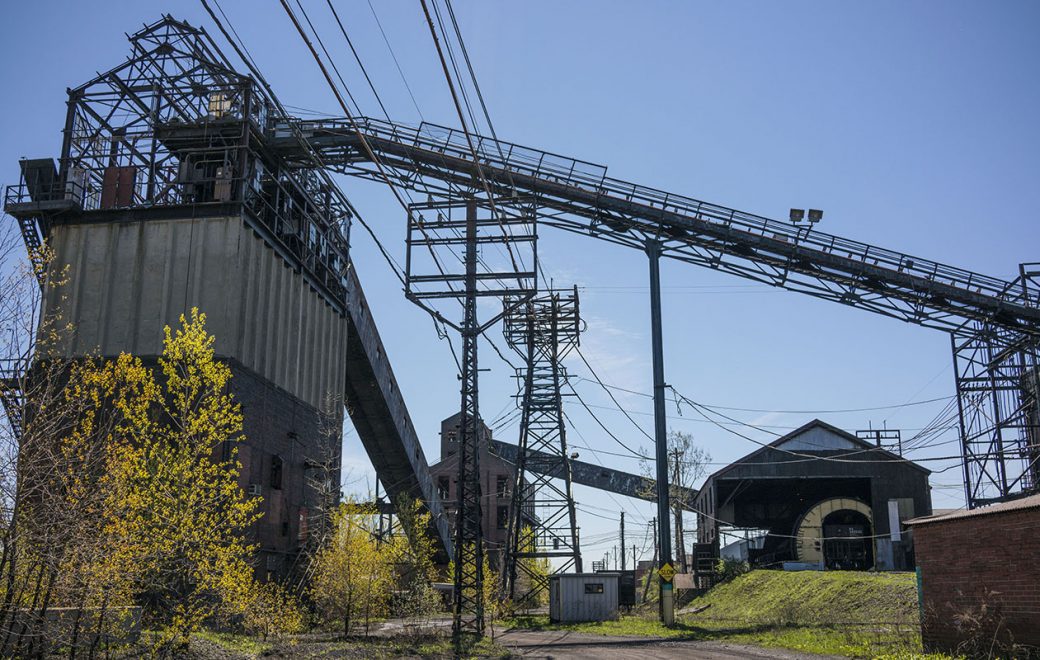Coal Won't Have a Turnaround in the U.S., But the Story is Different Elsewhere

By Don Paul
September 8, 2019 - It’s true we are using less coal in the United States. Coal is more expensive for power generation than natural gas, and that's a primary market driver in our domestic downturn of using coal as an industrial fuel.
The side benefit to that downturn is less carbon emission from our power plants, since natural gas — while still a fossil fuel — only emits about 40% of the carbon dioxide produced by coal combustion.
Until recently, the switch to natural gas had also been a major factor in what had been a significant reduction in U.S. carbon output, although our carbon emissions began to rise again recently. This new increase began despite a record number of shutdowns for coal-fired power plants.

Portions of the old coal management system at the former Bethelehem Steel site in Lackawanna in 2017. At right, rail cars full of coal are emptied.
Photo by Derek Gee, Buffalo News
According to the U.S. Department of Energy, an increase in carbon emitted by the transportation sector has outstripped domestic power generation as the biggest carbon source and has ended our market force-driven reductions. There has also been an increase in carbon emissions in the chemicals, steel and refineries sector of what has been our healthy economy. In our nation, this is not from coal; it’s from growth in those sectors tied to more power consumption in general.
Because of the costs, there is no evidence coal is going to have a turnaround in the U.S. market. However, our domestic trend is not representative of global trends. The same cost advantages to rapid large-scale conversion to natural gas here are not so evident in much of the rest of the world. U.S. coal exports have been on the rise, as detailed in a Yale Climate Connections article.
What is called steam coal is still a viable technology for power generation, and metallurgical coal is used in steelmaking, according to the Department of Energy. Due to coal remaining desirable in many sectors abroad despite its environmental costs, 15% of American coal production is now exported. Since China remains the largest consumer of coal, you might think the greatest proportion of our exports go there. However, in data compiled by British Petroleum, you may be surprised to learn environmentally conscious Europe is our No. 1 market for coal.
It appears many EU nations, while most observant of Paris Accord goals, still have some industries key to their economies in which they don’t yet have satisfactory substitute fuels. Growing demand for coal in these sectors has raised prices and made coal a more desirable export. China is a much smaller importer of our coal because China sits on the world’s third largest coal reserves. According to Yale, what coal China does import comes mainly from Russia, Australia, Mongolia and Indonesia. The United States, on the other hand, has the world’s largest coal reserves and exports all over the world.
North America and Europe (despite coal’s use in those industries) are leading the world in moving away from coal. And coal use is down off its peak consumption in 2013. Yet global coal consumption is still on the rise, British Petroleum statistics show.
Global coal use is again approaching the 2013 peak, and it is largely China and India that are driving this surge. It must be remembered that China and India, by huge margins, have the largest populations and growing economies. Their appetites for power generation during this growth is no surprise. Per capita, the United States remains the largest carbon emitter in the world. But nationally, we are hugely outstripped by China. Just three nations consume 71% of the world’s coal, and the United States is a distant third.
Russia has huge natural gas reserves, so you’ll note their not-so-healthy economy isn’t even on this coal graph. They export coal more than they use, owing to the state of their economy.
As for China, a tremendous paradox is in progress. China has suffered more deadly episodes of air pollution tied to its coal-fired power plants than any nation in history, with tens of thousands of premature deaths tied to the environmental effects of coal burning. While China is the biggest coal consumer, they are moving ahead more than any other nation in the development and use of alternative generation technologies to try to mitigate these deadly impacts. They lead the world in solar technology not only for themselves, but as a healthy investment target for export.
While China and observers may take some comfort in the steep upward curve of Chinese deployment of alternatives, growing much faster than most nations’ use of alternatives, it has to be noted Chinese advancements in these new technologies still leave coal and other fossil fuels in the vast majority of energy consumption technologies.
It could be argued that a good deal of Chinese power generation is also tied to their growing economy and exports to places like the United States. China also is third, behind the United States and the European Union, in the number of coal-fired plants which have been shut down. But China continues to build new coal-fired plants because the alternative technologies cannot yet adequately fuel the growth in their domestic and export industrial technologies.
The most discouraging part of this growth in coal consumption is how difficult it will make the achievement of holding the growth in global temperatures since the industrial revolution to 1.5 degrees Celsius in the next few decades (we’re up 0.9 degrees just since 1906, according to NASA). Most climate scientists, physicists, and oceanographers have good evidence that going beyond 1.5 degrees will lead to the very bad to worst case scenarios tied to warming. There is still some chance net carbon emissions could be reduced to near zero by 2050 if more nations accelerate their reduction in the use of fossil fuels, such as by closing more coal-fired plants.
As of this moment in time, meeting that goal is far from impossible, but it's looking less likely. There is always the hope of profits to be made by more rapid advancement in alternative technologies may speed along progress. After all, market forces have their allure.

